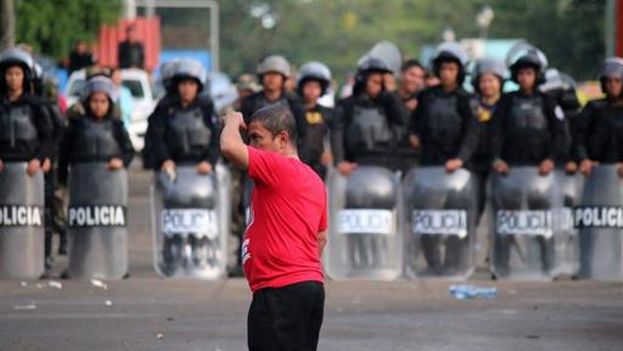
![]() 14ymedio, San Jose, Costa Rica, 15 December 2015 — The crisis of thousands of Cuban migrants stranded in Costa Rica has gone on for a month, as of Tuesday, and the authorities of that Central American country still have not found a regional solution that would allow the Cubans to resume their journey to the United States.
14ymedio, San Jose, Costa Rica, 15 December 2015 — The crisis of thousands of Cuban migrants stranded in Costa Rica has gone on for a month, as of Tuesday, and the authorities of that Central American country still have not found a regional solution that would allow the Cubans to resume their journey to the United States.
Since 14 November, Costa Rica has issued 5,366 transit visas to Cubans who arrived at their border with Panama, and 2,238 more are waiting to enter, according to data released to the press agency EFE today by the Department of Immigration (DGME).
The crisis began on 15 November when the government of Nicaragua decided to close its border with Costa Rica to Cubans and the police and army repelled some 800 who tried to cross illegally.
Costa Rica accused Nicaragua of “provoking” and “manipulating” the crisis to be able to blame the US immigration policies that benefit Cubans migrating without visas.
Since then, thousands of Cubans have been amassing in Costa Rica, a country that is maintaining 26 shelters, mostly in communities near the border with Nicaragua, which provide the Cubans with humanitarian aid, and altogether host some 4,000 islanders.
Costa Rica has never before had to deal with so many people for such a long time, not even during natural disasters.
The migrants have organized themselves and to take advantage of the free time they have decided to volunteer in the Costa Rican communities that have embraced them, as a way to show their appreciation for the hospitality.
Among the thousands of migrants there are children, pregnant women and professionals in medicine, architecture, education, and engineering, among others.
Almost all the Cubans carry passports because they left the island legally by plane for Ecuador, a country that until 1 December did not require a visa from them.
From Ecuador they traveled by sea and land through Colombia and Panama to reach Costa Rica.
The president of Costa Rica, Luis Guillermo Solis, is on an official visit to Cuba, where he hopes to address the immigration issue today with Cuban president Raul Castro.
Solis has ruled out the possibility of deporting Cubans back to the island, as he has said he is not willing to “play games with the migrants’ plans for their lives.”
Costa Rica has tried to find a solution, but on 24 November its proposal to create a regional humanitarian corridor failed to be approved at a meeting of foreign ministers of the Central American Integration System (SICA), along with Mexico, Ecuador, Colombia and Cuba.
According to Costa Rica, Mexico is willing to allow the passage of Cubans but only if they come through a land border, that is from Guatemala or Belize, countries that have refused to allow an airlift, to bypass Nicaragua, from Costa Rica.
Costa Rica’s government has criticized the “lack of solidarity” of the Central American countries and has called on SICA to “prove it can be useful” in situations like this.
President Solis will participate next Friday at the SICA Summit in El Salvador, where the Cuban migration crisis will be a priority issue.
